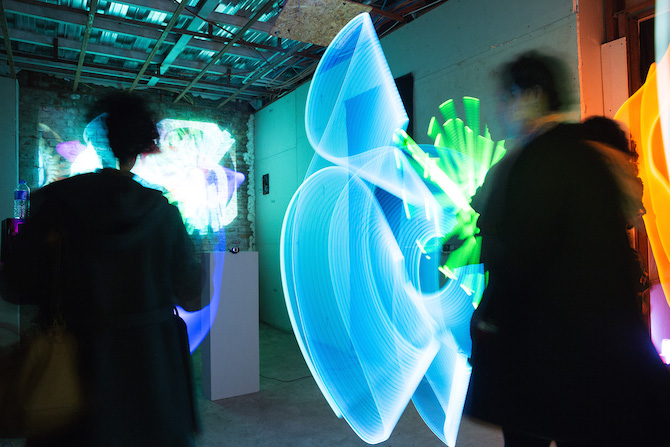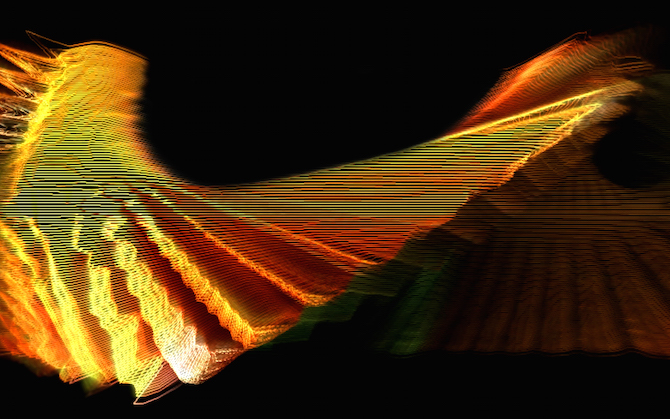
Buşra Tunç "Sinusoid" (2014), interactive light installation, "WAVES" exhibition at BLOK art space; photo © Rayna Teneva
Mine Kaplangi: Ebru, you are a sociologist, a researcher and a curator in new media arts based in Istanbul. What was your initial motivation to curate new media art exhibitions?
Ebru Yetişkin: Retrospectively, I somehow see that curating appeared as an inevitable choice in my life. Curatorial practice is also an important part of my critical research on contemporary social change. I am exploring and creating new conceptual dynamics that challenge our knowledge, perception and action in the worlds we live. Waves, cacophony, paratactic media and contagious bodies are among the recent ones I have suggested as such conceptual arguments. I find it almost impossible to explore the dynamics of contemporary political or economic change by merely using the conventional academic research methods. Most of the time, these methods, language barriers and knowledge circulation patterns become denials of access to even talk about the problem with others. I wanted to free myself from this suffocating space and make an intervention to extend the limits of my production and exchange relations with others. Today the collaborative power of art, science and technology paves a way to challenge the existing structures, and suggest alternative ways of thinking and doing things. In a way, I feel like, instead of becoming an obsessive follower of the rituals of academy and art communities, I wanted to experiment and multiply the possibilities of existing and mutating in alternative ways. I feel like I am only beginning.
MK: This year you are directing and curating the new media section of Contemporary Istanbul Art Fair, Plugin Istanbul. How is this process developing for you and what will visitors experience different than other years?
EY: My main goal is to extend the reach and variety of the viewers of new media art in Turkey. After learning that Contemporary Istanbul is the fifth most visited art fair in the world with 77.000 visitors, I decided to collaborate with Contemporary Istanbul for Plugin New Media Section. Plugin is in its third year and will not only host galleries, studios and independent artists but also initiatives in art, science, technology intersection, such as maker spaces, game labs, collaboration networks, digital art collectives, research universities. All participants of Plugin will present an artwork, which is related with their unique vision. Besides, there will be creative technology workshops for younger generations, talks and walks in the program. I think it will have a festival-like sense this year rather than a conventional art fair.
MK: The theme of this year’s Plugin is called “X-CHANGE”. What does this title suggest about the exhibition and the works involved?
EY: X-CHANGE is about exploring and presenting alternative ways of interaction, conversation and transformation. I think the existence of new media arts in an art fair should transcend the object-capital exchange. So we invited a wide range of artists, who are closely linked with the production and distribution of new media arts, and ask them to produce new works according to their conception of the curatorial theme and their exclusive approach. X-CHANGE extends its discussion nodes in a three-fold way. The first subtheme is “Matter: Organic/Inorganic Bodies”, in which participants of Plugin will focus on the exchange among the organic and inorganic bodies, such as fibers, cells, tissues, electrons, plants, neural networks etc. We also want to create new paths for reconnecting and learning from these hybrid life forms about how to survive and generate other worlds. The second subtheme is “Technology: Hi-tech & Low-Tech.” Here, we give the focus on the exchange among analog and digital, simple and complex mechanisms. We draw attention to the reuse and regeneration of waste and the wasted, such as time, bodies or materials. We also open a way for imagination of speculative futures from Istanbul’s perspective in this subtheme. And finally the last one is “Media: Transmission, Transcoding, Transaction, Transform:” In this section, we will work on different types and emerging conceptions of media, such as mushrooms or raindrops.
"Waves | Dalgalar", Re-Fluct - Kinetic Installation /// Deniz Kader, Curation: Ebru Yetişkin, Videography: Berkay Tunalı, Elif Demirci (datafobik), Istanbul,2015
MK: The first exhibition you curated was called “Cacophony” at Şekerbank Açık Ekran, then last year you curated another group exhibition called “Waves” at BLOK art space, and the third part of this series will be “Contagious Bodies.” How did you build this trilogy?
EY: The series is a way for me to explore the uncovered operations of political economy. I think we need to view and discuss contemporary change with new perspectives. For instance, in a data-driven world, today there is an emerging logic of power working in social media’s reliance on algorithms. These are for example Google’s Pagerank, Facebook Edgerank and Klout, which loosely correspond to Gilles Deleuze’s notion of the society of control and which has been recently named ‘algorithmic governance’. It is seen as the expression of a kind of joint governance of social networks with governments and corporations acting together while also competing with each other. Within the free spaces and temporalities of algorithmic platforms, micro bits of quotidian practices are subsumed into capitalist value and transacted to third parties, such as advertising agencies, banks, and pharmaceutical, biotech and insurance companies. “Cacophony” is about the use of error and noise to maintain authority and power. Different types of “waves” reveals the distributional patterns of action, knowledge and perception. “X-change” is about the mutual interaction and transaction of various actors and “contagious bodies” is to explore how mutation is processed and realised among organisms, materials and machines.
MK: How is this concept of algorithms connected to the social changes that you observe?
EY: We experience that conflicts are instrumentalised to associate and regulate initiatives of resistance. In order to prove the need for absolute power, the state, and its logic of governance, crisis situations are used to reconnect random deviations to the discourse networks of global elites, which are based on national security, economic development, financial stability, justice and the war on terror. For instance, recent resistance movements at a global level revealed that the increasing mutual interactions with other resistance movements at local contexts have revived some shared concerns about the spread of excessive coercion, destruction and corruption. However, when agents of resistance are depleted enough, their desire and belief to possess popular values, such as democracy, equality, justice and freedom, could be limitlessly postponed in continuous variation. Then the need for existing structures and static antagonisms, like state and citizen, are repeated, reproduced and maintained. For the depletion of resisting agents, provocative statements, risks, uncertainties and traumatic events are superimposed almost in an orchestrated fashion within a certain period of time. The conflict between disputing parties is preserved and fuelled by the bombardment of polemics, speculations, conspiracy theories and deceits to discredit those temporarily gaining power.
Tarleton Gillespie argues, “To efficiently design algorithms that achieve a target goal, algorithms are ‘trained’ on a corpus of known data. The algorithm is then run on this data.” Popular stereotypes are considered to be such a corpus of known data. They serve to attract and distract the attention so that the algorithmic operations can be run on the data-flows generated by the noise of reactionary agents. When reactions reach a certain point in which they lead to surplus, such as an unwanted change, they are removed, liquidated and devalued, like marginal, irrational and criminal looters, as in the case of the Gezi Park Protests. In this way, agents of resistance are super-stimulated and their affective resources can be extracted, and put into work to produce data via algorithmic schemes, such as the data flow of tweets toward a provocative statement. If the frequency of this process increases, then resisting agents are depleted, consumed and wasted. It is this waste, which is processed and reused to reproduce dominant patterns.
MK: Your choice of concepts for all exhibitions remind of social-revolutions. Do you think these collaborative studies of art will and can lead us to a revolution in media, politics and in our community?
EY: Absolutely not. Well, I don’t think I believe in revolutions. For me, there are only mutations that have major and minor distributional patterns, which lead to innovation, regeneration and differentiation. Michel Callon discusses that the socio-economics of innovation uses the image of the ‘turbulent process’ in order to describe the interactive nature of innovation. I like that idea. Perhaps these conceptual suggestions seems alien or in opposition for some today. I only hope these works contribute to enforce the power of imagination so that we can trigger new possibilities for creating better futures.
Artists: Mehmet Ali Boran, Mehmet Ceper, Curator: Ebru Yetiskin, 13 November 2014 – 11 December 2014, 42Maslak Art!Space, Istanbul
MK: What do you think about the reactions to new media and digital arts in Turkey?
EY: New media arts is growing with individual interests and minor initiatives in Turkey. The lack of institutional support and funding is limiting. Despite the huge amount of advertising, PR and investment budgets, universities, research labs, big corporations, municipalities and companies have only a short-term interest in collecting and funding. Conventional distinction between scientific and artistic representation is still too prevalent as well. These facts have a big impact on the content and production phases of the artworks. In contrast to 2000s, today there is a tendency of repeating the existing patterns and forms instead of conducting research with artistic practice. Besides, there is a general misconception in the contemporary art professionals about new media arts. Most people think that if a work, which has some sort of aesthetic components, operates with digital media, it is described as new media arts. I do not agree with that. I believe a new media artwork should suggest a creative way for us to perceive, feel and act in the worlds we live by integrating alternative forms of media, which can be digital or biological as well. In order to that, new media artists should have a capacity to explore, read and intervene the processual dynamics of political-economic change since contemporary capitalist cultures are operating with algorithmic and neuro-tech schemes today.
UPCOMING SHOWS
Contemporary Istanbul PLUGIN
X-CHANGE
12-15 November 2015
contemporaryistanbul.com
Website: istanbultek.academia.edu/EbruYetiskin

Buşra Tunç "Sinusoid" (2014), interactive light installation, "WAVES" exhibition at BLOK art space; photo © Rayna Teneva
Contemporary Istanbul PLUGIN
X-CHANGE
12-15 November 2015
contemporaryistanbul.com
Website: istanbultek.academia.edu/EbruYetiskin

Buşra Tunç "Sinusoid" (2014), interactive light installation, "WAVES" exhibition at BLOK art space; photo © Rayna Teneva
 Erdal İnci "Farmaphone" (2014), interactive audio-visual instrument and performance, "WAVES" exhibition at BLOK art space; photo © Rayna Teneva)
Erdal İnci "Farmaphone" (2014), interactive audio-visual instrument and performance, "WAVES" exhibition at BLOK art space; photo © Rayna Teneva)  Ozan Turkkan "Bipolar Fractal" (2013), Cacaphony exhibition at Açıkekran Gallery
Ozan Turkkan "Bipolar Fractal" (2013), Cacaphony exhibition at Açıkekran Gallery
